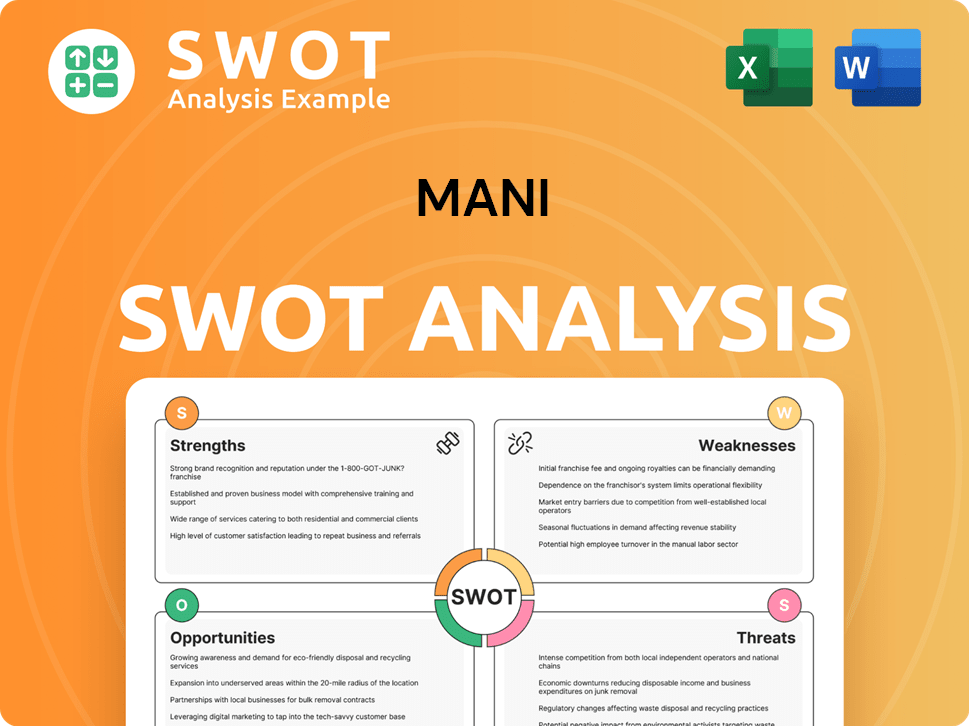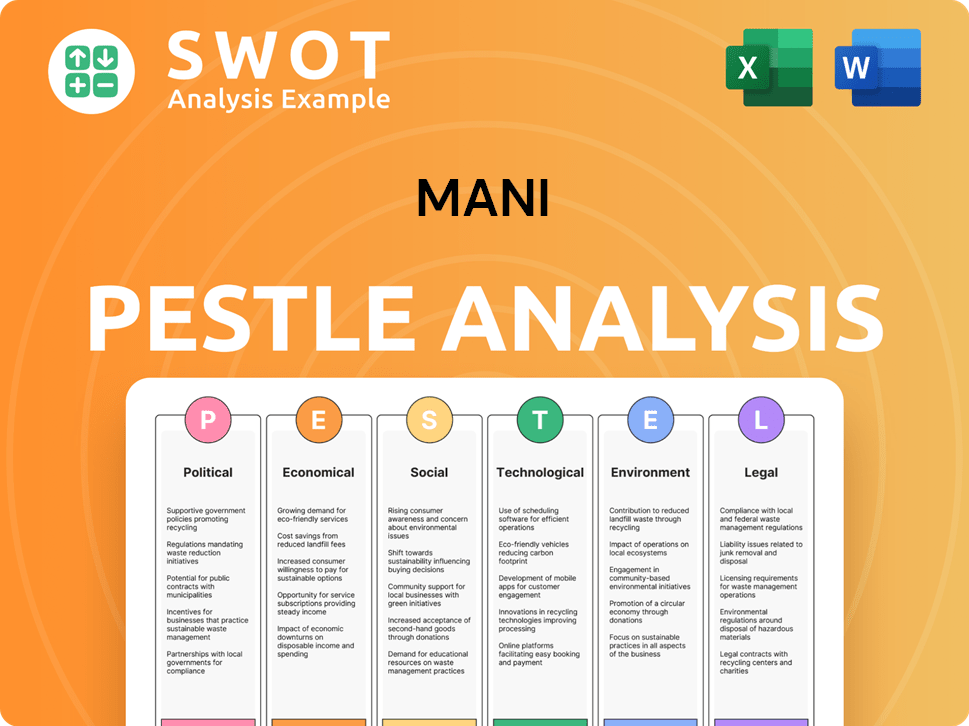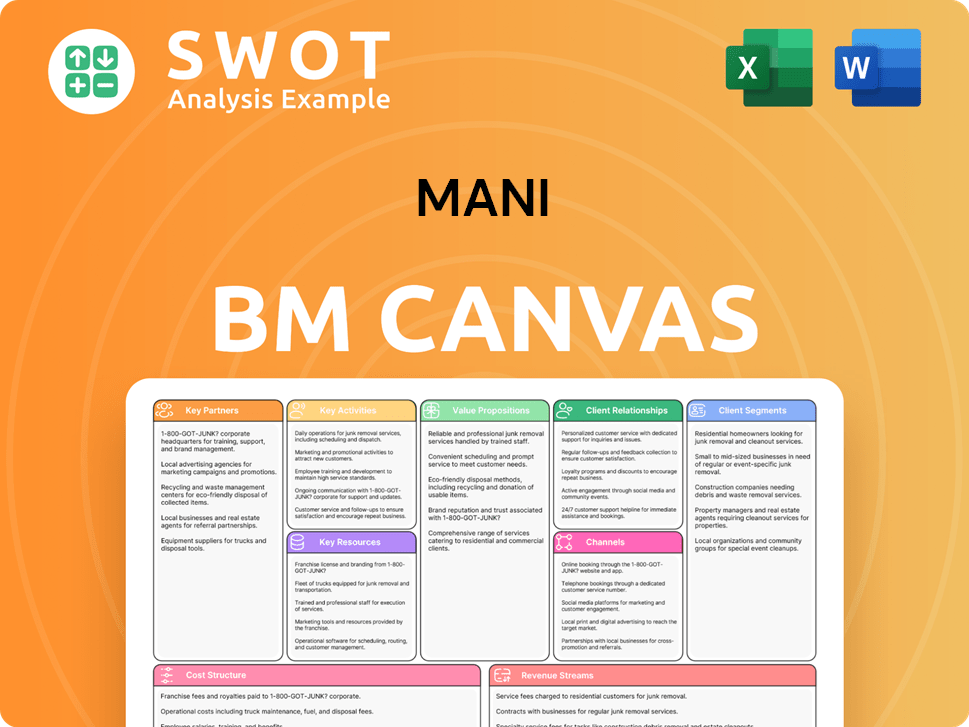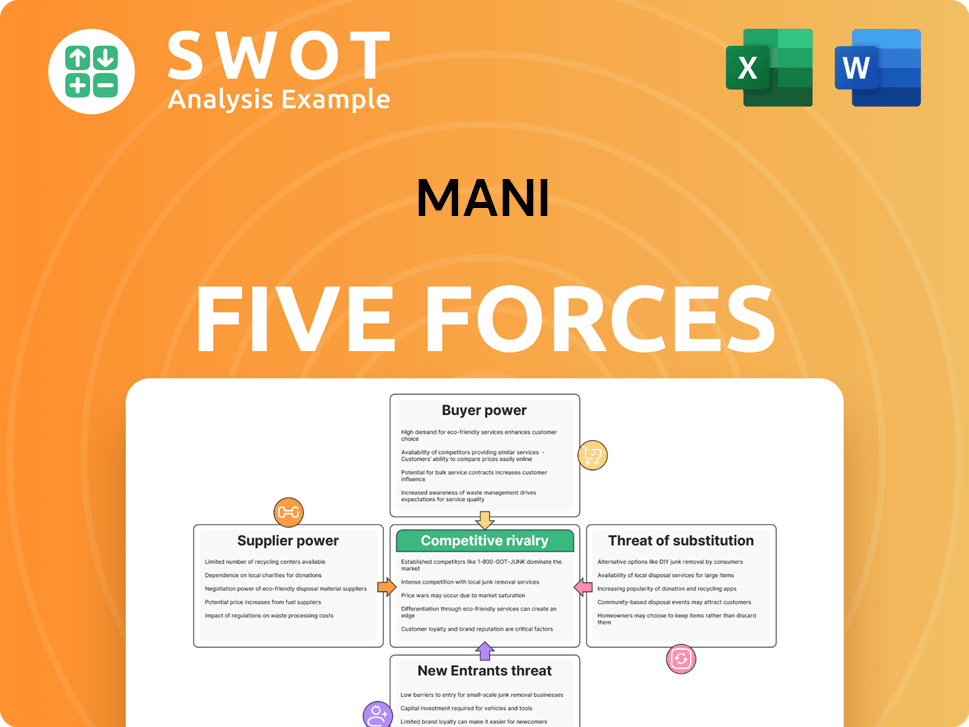Mani Bundle
How Does Mani Company Thrive in the Global Healthcare Market?
MANI, INC. stands as a global force in medical and dental markets, crafting high-quality surgical and dental instruments, alongside ophthalmic surgical devices. With a commitment to "The Best Quality in the World, to the World," MANI serves over 120 countries, playing a vital role in advancing global medical care. As of February 2025, MANI's trailing 12-month revenue hit $193 million, showcasing its significant financial presence.

This analysis explores the intricacies of Mani SWOT Analysis, examining its surgical instrument manufacturer processes, and its position as a dental instrument supplier. We'll dissect MANI's core operations, revenue streams, and strategic milestones to understand how it maintains its competitive edge. Understanding "How does Mani Company manufacture surgical instruments" and its adaptability to market demands is crucial for investors and industry observers alike, especially considering its recent strategic expansions and challenges, such as the dental burs recall.
What Are the Key Operations Driving Mani’s Success?
The core operations of the company, a prominent player in the medical device industry, center around the development, manufacturing, and distribution of precision medical and dental instruments. These instruments are essential tools for medical professionals globally. The company's product range includes surgical, ophthalmic, and dental instruments, catering to a wide array of medical procedures.
The company's value proposition lies in its specialized microfabrication technologies, particularly in stainless steel, which allows it to produce high-quality consumables. These instruments are known for their sharpness and mechanical properties, crucial for minimally invasive procedures. The company focuses on niche markets where its expertise provides a competitive edge, aiming to be a world leader in specific product categories.
The company's commitment to quality and innovation is evident in its manufacturing processes and product development. By collaborating with key opinion leaders worldwide, the company ensures its offerings meet the demanding needs of top physicians, enhancing customer benefits and market differentiation. This approach has allowed the company to establish a strong presence in the global market.
The company's product offerings are segmented into Surgical-related Products, Eyeless Needle-related Products, and Dental-related Products. These include surgical suture needles, ophthalmic knives, dental burs, and endodontic instruments. The variety ensures that medical professionals have the right tools for various procedures.
The company's manufacturing is based on microfabrication technologies, particularly in stainless steel. This allows for the production of small-sized, high-quality instruments. Safety and precision are prioritized to create robust instruments, minimizing risks during surgical procedures. The company maintains production bases in Japan and Vietnam.
The company's products are supplied to over 120 countries, with a global supply chain and distribution network. The company strategically expands its production capabilities and sales channels. This includes establishing new sales subsidiaries to enhance regional-oriented sales and marketing activities, especially in emerging markets.
The company aims to be a world leader in specific product categories, such as ophthalmic knives, where it holds approximately 30% of the global market share. This specialization, coupled with product development in collaboration with key opinion leaders, ensures that the offerings meet the needs of top physicians. The company's focus on niche markets provides a significant competitive advantage.
The company's operations are defined by its focus on precision, quality, and global reach. The company's commitment to innovation and customer satisfaction is evident in its product development and market strategies. The company's history and background are integral to its current success, as detailed in Brief History of Mani.
- Manufacturing: Production bases in Japan and Vietnam, with expansion plans.
- Sales Network: Global distribution to over 120 countries.
- Market Focus: Specialization in niche markets with a strong market share in specific categories.
- Innovation: Product development in collaboration with key opinion leaders.
Mani SWOT Analysis
- Complete SWOT Breakdown
- Fully Customizable
- Editable in Excel & Word
- Professional Formatting
- Investor-Ready Format

How Does Mani Make Money?
The revenue streams and monetization strategies of the company are centered around the sale of its specialized medical and dental instruments. The company focuses on providing high-quality, precision instruments, which allows it to employ premium pricing strategies for certain products. This approach, combined with strategic market expansion, has driven significant revenue growth.
For the fiscal year ending August 31, 2024, the company's net sales reached ¥28,513 million (approximately $193 million USD), marking a 16.4% increase year-on-year. This growth was fueled by increased sales across Asia, North America, and Europe, with the depreciation of the yen also contributing to overseas sales figures. The company's commitment to quality and strategic market penetration are key drivers of its financial performance.
The company's revenue is segmented into three main categories: Surgical-related Products, Eyeless Needle-related Products, and Dental-related Products. Each segment contributes differently to the overall revenue, with varying growth rates and profitability levels. The company also focuses on expanding its product lineup and market presence to meet customer needs and drive future sales.
The primary revenue streams for the company are derived from the sales of its medical and dental instruments. These instruments are categorized into Surgical-related Products, Eyeless Needle-related Products, and Dental-related Products. The diversity in product offerings supports its revenue generation.
For the fiscal year ending August 31, 2024, net sales reached ¥28,513 million, a 16.4% increase year-on-year. The nine months ended May 31, 2024, saw net sales of ¥21,610 million, up 16.7% year-on-year. These figures highlight the company's strong sales performance.
The Surgical-related Product segment reported sales of ¥8,152 million, a 20.2% increase year-on-year. This growth was driven by demand for ophthalmic knives, particularly in Asia, Europe, and North America. The company's focus on high-quality surgical instruments is evident in this segment's performance.
The Eyeless Needle-related Product segment generated sales of ¥10,222 million, up 19.2% year-on-year. This segment is also noted as the most profitable among all segments. Increased orders in Asia and North America drove the growth in this segment.
The Dental-related Product segment recorded sales of ¥10,139 million, an 11.1% increase year-on-year. However, sales of MMG products (dental restoration materials) were weak, and the segment experienced a sales decline of ¥586 million year-on-year, mainly due to a voluntary recall of dia-burs in China in October 2024.
The company's monetization strategies emphasize the value and high quality of its precision instruments. The company prices some surgical needles 50% to 100% higher than competitors due to their established reputation. The company sets prices for its dental drill and surgery products at comparable or slightly lower levels as it entered these segments later.
The company is implementing several strategies to expand its market presence and drive future sales. These initiatives include establishing new sales subsidiaries and expanding its product lineup. The company's focus on quality and strategic market expansion is a key driver of its financial performance. To learn more about the company's strategic approach, consider reading Growth Strategy of Mani.
- Establishing new sales subsidiaries in North America and Malaysia in 2024.
- Focusing on expanding its product lineup for key development products like 'JIZAI'.
- Regional-oriented sales approach to capture medical trends and expand business foundation.
Mani PESTLE Analysis
- Covers All 6 PESTLE Categories
- No Research Needed – Save Hours of Work
- Built by Experts, Trusted by Consultants
- Instant Download, Ready to Use
- 100% Editable, Fully Customizable

Which Strategic Decisions Have Shaped Mani’s Business Model?
The journey of the Company, a prominent player in the medical device industry, is marked by significant milestones and strategic decisions. Founded in 1956, the company has evolved from a pioneer in microfabrication to a global entity. Its commitment to innovation and quality has established it as a key manufacturer of surgical and dental instruments.
The company’s strategic moves have focused on global expansion and production optimization. Recent initiatives include establishing sales subsidiaries in Southeast Asia and North America. These efforts are part of a medium-term plan to globalize sales and production functions. Simultaneously, the company is investing in advanced manufacturing facilities to enhance efficiency and meet growing market demands.
Despite facing operational challenges, the company maintains a strong competitive edge through its proprietary technologies and product quality. Its microfabrication expertise, particularly in stainless steel, allows for the creation of highly precise instruments. The company's focus on niche markets and strong brand recognition contribute to its sustained success in the industry.
The company's history includes significant innovations. In 1961, it produced the world's first '18-8' stainless steel surgical needle. The introduction of the world's smallest drilled eyeless needle in 1991 further demonstrated its commitment to pioneering technology. The company's achievements were recognized with the Porter Prize in 2008.
Recent strategic moves include expanding its global presence. The establishment of MANI MEDICAL DEVICE MALAYSIA SDN. BHD. in November 2023 and MANI MEDICAL AMERICA, INC. in September 2024 are key steps in this direction. These initiatives support the company's medium-term plan to globalize sales and production. A new smart factory is planned for Japan, with mass production starting in 2025-2026.
The company's competitive advantage lies in its unique core technologies and product quality. Its microfabrication technologies, especially in stainless steel, enable the creation of precise instruments. The company holds approximately 30% of the global market share in ophthalmic knives. Its strategy focuses on dominating niche markets.
The company has faced challenges, including a voluntary recall of MANI DIA-BURS in China in October 2024 due to incomplete product registration. The company is addressing this by strengthening quality assurance. Underperforming market share expansion in Europe and North America requires a redesign of their business model to compete with major global players.
The company's growth strategy involves continuous innovation and market expansion. The company's focus on quality and precision has solidified its reputation as a leading surgical instrument manufacturer. The company's adaptability to new trends is evident in its ongoing product development and expansion of product lines like the 'JIZAI' NiTi rotary file. To learn more about the company's growth trajectory, consider reading Growth Strategy of Mani.
- The company's global distribution network supports its reach in various markets.
- The company's quality control process ensures the highest standards in manufacturing.
- The company's product warranty information reflects its commitment to customer satisfaction.
- The company's contact information is readily available for customer inquiries.
Mani Business Model Canvas
- Complete 9-Block Business Model Canvas
- Effortlessly Communicate Your Business Strategy
- Investor-Ready BMC Format
- 100% Editable and Customizable
- Clear and Structured Layout

How Is Mani Positioning Itself for Continued Success?
The Mani Company holds a strong position in the medical and dental instrument industry, particularly in niche segments. They are a surgical instrument manufacturer. Their ophthalmic knives alone hold approximately 30% of the global market share. They are also a dental instrument supplier. While facing competition, their focus on microfabrication allows them to excel in high-value products, with a global reach extending to over 120 countries.
However, the company faces risks like regulatory changes, intense competition, and technological disruption. For example, a voluntary recall of dental burs in China in October 2024 due to incomplete product registration. Over-reliance on the Vietnam factory, which produces over 90% of their main products, also presents a risk, though they are addressing this through expansion and a new factory in Japan.
Mani Company excels in niche markets within the medical and dental instrument industry, particularly in ophthalmic knives. Their products are known for 'The Best Quality in the World, to the World.' This reputation supports customer loyalty and drives product development and manufacturing processes.
Key risks include regulatory changes, intense competition from major global players, and technological disruptions. Over-reliance on overseas production, with over 90% of main products made in Vietnam, presents a significant challenge to the company. The company must continuously innovate and adapt to maintain its market position.
The future outlook for Mani Company is based on strategic initiatives for growth and profitability. These include establishing a high-quality, low-cost global production system and expanding its market share in emerging countries. Their medium-term management plan aims to achieve ¥30 billion in net sales by the fiscal year ending August 31, 2026.
Key initiatives include factory expansions, R&D with key opinion leaders, and expanding global market shares. Reforming the management platform and organizational structure to strengthen quality assurance and business operations is also a priority. They are also focusing on expanding into new areas within ophthalmic surgery.
Mani Company aims to expand its ability to make money by focusing on niche markets and leveraging its unique core technologies. They are expanding into new areas within ophthalmic surgery to diversify their product portfolio.
- Factory expansions and smart factory development.
- R&D with key opinion leaders to drive new product development.
- Expanding global market shares, particularly in emerging countries and North America.
- Reforming management and organizational structure to strengthen quality assurance.
Mani Porter's Five Forces Analysis
- Covers All 5 Competitive Forces in Detail
- Structured for Consultants, Students, and Founders
- 100% Editable in Microsoft Word & Excel
- Instant Digital Download – Use Immediately
- Compatible with Mac & PC – Fully Unlocked

Related Blogs
- What are Mission Vision & Core Values of Mani Company?
- What is Competitive Landscape of Mani Company?
- What is Growth Strategy and Future Prospects of Mani Company?
- What is Sales and Marketing Strategy of Mani Company?
- What is Brief History of Mani Company?
- Who Owns Mani Company?
- What is Customer Demographics and Target Market of Mani Company?
Disclaimer
All information, articles, and product details provided on this website are for general informational and educational purposes only. We do not claim any ownership over, nor do we intend to infringe upon, any trademarks, copyrights, logos, brand names, or other intellectual property mentioned or depicted on this site. Such intellectual property remains the property of its respective owners, and any references here are made solely for identification or informational purposes, without implying any affiliation, endorsement, or partnership.
We make no representations or warranties, express or implied, regarding the accuracy, completeness, or suitability of any content or products presented. Nothing on this website should be construed as legal, tax, investment, financial, medical, or other professional advice. In addition, no part of this site—including articles or product references—constitutes a solicitation, recommendation, endorsement, advertisement, or offer to buy or sell any securities, franchises, or other financial instruments, particularly in jurisdictions where such activity would be unlawful.
All content is of a general nature and may not address the specific circumstances of any individual or entity. It is not a substitute for professional advice or services. Any actions you take based on the information provided here are strictly at your own risk. You accept full responsibility for any decisions or outcomes arising from your use of this website and agree to release us from any liability in connection with your use of, or reliance upon, the content or products found herein.